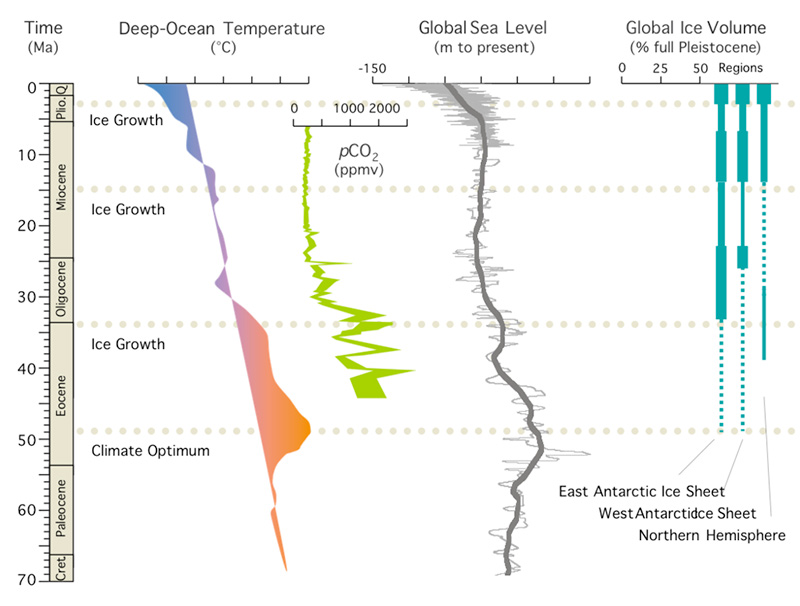
On another EarthDate, we talked about Greenhouse and Icehouse periods in Earth’s history that last hundreds of millions of years. In Greenhouse times, temperatures rise and life flourishes. And in Icehouse periods, temperatures fall and life can struggle.
Why does Earth alternate between these extremes? Research points to plate tectonics and volcanic activity.
Plate movement causes continents to be pulled apart and pushed together, with varying amounts of volcanic activity.
When there’s lots of activity, volcanoes emit huge volumes of CO2 and methane into the atmosphere, which can trap enough heat to bring about a Greenhouse period.
Conversely, when volcanic activity decreases, CO2 and methane decrease, and the Earth can cool.
Continental movement also affects ocean circulation. If Earth’s poles become isolated from the warm waters near the equator, they can freeze more easily.
And plate movement can bury large volumes of organic carbon in sediment layers, stopping it from reentering the atmosphere.
Within Icehouse periods, there are shorter glacial cycles, interrupted by milder interglacials, like the one we’re in today. Earth alternates between more ice and less ice mostly because of changes in its orbital path.
When Earth’s orbit stretches farther from the sun, Earth cools and continental glaciers form. When it moves back closer to the sun, the ice melts.
Understanding the causes of these long-term and short-term climate cycles helps us to better understand the complexities of Earth’s climate today.
Background
Synopsis: What causes the transitions from Greenhouse Earth to Icehouse Earth and back again, which have profoundly shaped the evolution of life on Earth?
- Atmospheric concentrations of greenhouse gases like carbon dioxide (CO2) and methane (CH4) are higher during Greenhouse Earth, trapping solar energy in the atmosphere through the greenhouse effect.
- Without this protective atmospheric blanket, Earth’s surface would be frozen.
- Weathering of silicate rocks and burial of organic carbon consume CO2; volcanism and oxidation of organic carbon release CO2.
- The continual motion of tectonic plates changes the location, shape, and size of continental masses, altering atmospheric and oceanic circulation.
- If warm water flow from the equator to the poles is blocked, ice sheets result.
- The Antarctic Circumpolar Current developed as a result of the Cenozoic separation of Australia, Antarctica, and South America, which thermally isolated Antarctica.
- The Arctic Sea has limited circulation because it is nearly landlocked.
- Tectonic closure of the Isthmus of Panama between North and South America ~2.8 million years ago cut off circulation between the Atlantic and Pacific Oceans just before the start of the Quaternary Ice Age, causing the Gulf Stream current to make a U-turn back across the Atlantic to warm the climate of Western Europe at a critical time in human evolution.
- Cenozoic collision between India and Asia created the Himalayas, which diverted northern hemisphere winds and increased global precipitation as their elevation increased. Growth of these young mountains also helped shut off some volcanic CO2 fluxes and consumed carbon dioxide during the weathering of fresh silicates.
- If warm water flow from the equator to the poles is blocked, ice sheets result.
- Along active continental margins like the Andes, subduction of organic sediments and limestones creates volcanic arcs that produce large quantities of CO2 as magmatic heating liberates carbon. Clouds of gas and tiny shards of melted rock billow up into the atmosphere during eruptions and can be distributed around the globe.
- Recent studies show that over the past 720 million years, icehouse conditions preferentially occur when supercontinents are assembled and continental volcanism wanes.
- Conversely, greenhouse periods appear to correlate with times of continental breakup and increased volcanism.
- Large meteorites can vaporize rocks at their impact site, ejecting gases and particulates high into atmospheric circulation patterns. The composition and toxicity of the ejecta reflect the composition of both the meteorite and the impact site.
- During Icehouse conditions, “glacials” and warmer “interglacials” occur on the order of tens to hundreds of thousands of years.
- For the most part, these cycles are correlated to variations in Earth’s orbit around the sun. First documented by Milutin Milanković, these predictable sequences—known as Milankovitch Cycles—constructively and destructively interfere.
- Orbital eccentricity indicates changes in the shape of Earth’s orbit from nearly circular to elliptical in a 100,000-year cycle, impacting the distance from Earth to the sun.
- Obliquity refers to the axial tilt of Earth, which varies from 21.5° to 24.5° every 41,000 years, impacting the intensity of seasons.
- Precession describes the wobble of Earth’s rotation about every 19,000–26,000 years.
- Within glacial periods, ice sheets advance or retreat in much shorter pulses of colder “stadials” and “interstadials.”
- Research shows that at the start of a glacial period, ice sheets grow very slowly (80–90 percent of the cycle) then, during interglacials, collapse fairly quickly (10–20 percent of the cycle).
- More than a dozen glacial–interglacial cycles have occurred in the past million years of our current Quaternary Ice Age.
- The largest glacial episode peaked 650,000 years ago and lasted 50,000 years.
- The most recent episode peaked 18,000 years ago and is known as the Last Glacial Maximum.
- The current interglacial period—the Holocene—began about 11,700 years ago. Continental ice sheets remain in Greenland, the Arctic, and the Antarctic.
- For the most part, these cycles are correlated to variations in Earth’s orbit around the sun. First documented by Milutin Milanković, these predictable sequences—known as Milankovitch Cycles—constructively and destructively interfere.

